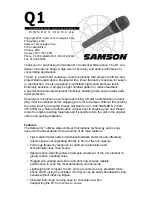
superior wind protection compared to many other ribbon microphones
so that the microphone can be used for recording vocals without the
need for a pop-filter. Nonetheless, using it outdoors requires special
care to avoid wind which can damage the ribbon. Indoors, however,
it is also important to avoid serious air movement from stage curtains,
open windows, doors, or air-conditioning systems. Use the supplied
cloth bag to cover the microphone whenever it is not in use. High SPL
sound sources do not usually pose a problem because most ribbon
microphones can handle 130 dB SPL or more without difficulty. It
is only those “explosive” sources that produce a strong blast of air,
such as the bass port on an electric guitar or bass amp, a guitar being
plugged (or unplugged) while the amp level is turned fully up, an on-
axis kick-drum (particularly with a port on the front head), that are
potentially damaging. If you are unsure about how much wind is hitting
the microphone, place the back of your hand where the microphone is
going to be. If you can feel significant wind blasts, angle the microphone
or use a pop screen to avoid direct hits.
Tramp Iron
Minute iron particles, sometimes known as “tramp iron,” are common
within our environment. AEA ribbon microphones contain powerful
magnets that produce strong magnetic fields. These fields can attract
any ferric metal near the microphone that, if they are small enough, can
penetrate the outer screening and work their way inside the microphone.
Over time, this “tramp iron” can build up sufficiently in the magnetic gap
to rub against the ribbon causing distortion, electrical shorts or tearing
of the ribbon. The best prevention is to keep the microphone covered
with the supplied plastic bag when it is not in use.
Under no circumstances should you disassemble and take the grill off of
the microphone as this could allow tramp iron to enter the narrow gap
between the ribbon and the pole pieces. Disassembling the microphone
will VOID your warranty.
Microphone Positioning
The shock-mounted clip that is supplied with the N22 microphone
was designed to keep structure-borne noise transmitted through the
microphone stand away from the low-tuned ribbon transducer. For the
shock mount to function as intended and to avoid vibration entering
the microphone through its attached cable, it is important to tie the
microphone cable to the microphone stand in a loop with a cable tie,
shoelace or string.
10
































